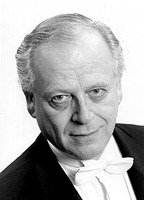S & H Concert Review
Kurtag and Bartok, Ildikó Vékony (cimbalom), BBC Symphony Orchestra & Singers, Zoltan Peskó, Barbican Centre, 29th April, 2003 (AR)
Bartok Dance Suite
Kurtág Messages
Kurtág Splinters
Kurtág New Messages (BBC co-commission: London premiere)
Bartok The Miraculous Mandarin (Complete)GyÖrgy Kurtág is not a house-hold name to a conservative concert-going public that tends to be locked in what cultural critic Theodor Adorno called ‘the worn grooves of association’ - preferring to hear the harmonic ‘tunes’ of ‘what they know’. For Adorno, as for Kurtág, it is dissonance which destroys the illusion of reconciliation represented by harmony, and that makes the public panic. It was therefore no surprise that the hall was only one third full for this concert.
Kurtág’s music is not ‘easy listening’, and his Messages Op.34 is an extraordinary experience in that one is removed from one’s expectations and experiences of listening to classical music. Here this counter-music or non-music breaks away from the narrative structure of a developing line of sound. In the fifth part of New Messages Op 34a (BBC co-commission: London premiere) there seemed to be a (subconscious?) allusion to Strauss’s Elektra (‘I could not give him the axe!’) where the cello’s suddenly burst in with a shuddering jagged attack, but here Kurtág fragments the music into smaller bursts of splintered sound, often making the spaces equally as important and relevant as the notes. We are in a Weberian world of miniatures, vignettes, implosions of sound and sudden pauses, where the sound becomes nothingness itself – the sound of silence. Kurtág’s musical silences could be said to constitute a Heideggerian being-towards-nothingness.
Veteran Hungarian conductor Zoltan Peskó cued rather than conducted this ‘contra-music’ very much in the manner of Bruno Maderna and Pierre Boulez: clear-cut with a surgical precision. The brass and percussion sections played these difficult works with exemplary skill and attack. After such an experience, which was as much to do with silence as with sound, it seemed inappropriate to have the loud clapping which greeted the end of the performances. Indeed, after each of Kurtág’s compositions of distillation and distance, the applause seemed violently intrusive, and broke the aura of silence that makes these scores so unique and unusual. It is worth remembering that both Webern and Schoenberg were against the bourgeois convention of applause when some of their compositions were performed.Kurtág’s Splinters for solo cimbalom (after poetry by Janos Pilinszky) was played between the two Messages and performed with concentrated intricacy by Ildikó Vékony in a blacked out auditorium.
These four ‘fragments’ were dedicated to the cimbalom virtuoso Márta Fábián, who gave the world premier in Budapest on 12th April, 1975. Again these ‘counter-music’ miniatures demanded critical attention from the audience. Once again using juxtaposition of sound and silence, Kurtág is as concerned with ‘positive silences’ as he is with ‘negative sounds’, with the cimbalom taking on a multiplicity of moods, which in turn have the effect of making the surrounding ‘blank’ spaces sound different. This may sound abstract, even metaphysical but it is not: different sounds make us experience silences in different ways.
Kurtág was smuggled in and served up in a Bartok sandwich which deadened the pain of contemporary music, but Bartok’s sound world is close to Kurtág’s in its anarchic dissonances, expressionist palette and irregular rhythms.
Peskó’s conducting of Bartok’s Dance Suite was rhythmically taut with the complex speed changes perfectly judged. Although he secured incisive playing from his forces, what was lacking was the essential weight and grain in the strings which this score demands - the strings seemed to have neither presence nor attack.
The second half was taken up by an intensely invigorating performance of Bartok’s Pantomime in One Act, The Miraculous Mandarin, Op.19.
From the outset, Peskó had total control over this demanding score understanding the complex inner counterpoint of the jagged rhythms, and combining a sense of threatening tension with an inexorable momentum.
Here the conductor was more concerned with the structure of the score rather than surface sensational special effects (which this music often lends itself to under some more flashy of today’s conductors). The internal spiky textures all came through even when the orchestra was playing at full force.
Throughout the performance, the exacting timpani playing was meticulously handled, as were the nightmarish percussion, snarling trumpets and trombones. The most astonishing aspect of this magnetic performance was the evocative and expressive playing of the woodwind. An important detail often blurred was the primordial growling contra-bassoon (accompanied by a quietly menacing timpani roll).
However, as with the playing of the Dance Suite, the strings again lacked the grainy bite and heavy attack that is so imperative to this violent score. The BBC Singers gave us a more sensuous sound in the hushed murmurings of the closing passages than we normally hear.
Throughout the concert, every gesture Peskó made was for his players – not for him mere playing to the gallery. He was serving the composers and his performers and not his own ego: a rare musician in this age of the personality cult of the conductor.
Alex Russell

 Return to:
Return to: